How to Read a Electrophoresis Gel and See Who the Father Is
102 Gel Electrophoresis and Dna Fingerprinting
Gel Electrophoresis
DNA is a very negatively charged molecule because each phosphate group in each nucleotide has a negative charge (Figure 1). This means that if an electric electric current is run through a Dna sample, the Deoxyribonucleic acid molecules will movement towards the positive accuse of the current. Scientists take advantage of this belongings of Dna in guild to separate Deoxyribonucleic acid molecules by size.
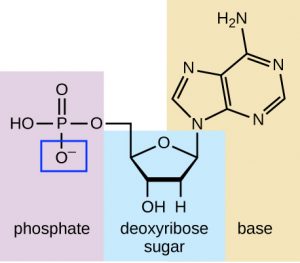
Agarose is a molecule that is purified from seaweed. Agarose powder is mixed with water, so heated until the powder dissolves. The mixture is poured into a tray (Figure two) and allowed to cool. As information technology cools, information technology forms a semi-solid gel. This process is similar to making Clot-o, if you've ever done that. This gel contains microscopic pores (holes) of dissimilar sizes. You lot can imagine the gel structure as looking like a thick hedge or blackberry bush-league. The structure of a hedge or blackberry bush is similar to the polysaccharide matrix that makes upwards an agarose gel (many molecules criss-crossed every which manner).
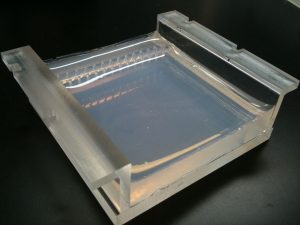
DNA can be fatigued through the agarose gel using an electric current because the negatively charged Dna molecules are attracted to a positively charged electrode. Small Dna molecules (short nucleotide chains made of a minor number of base pairs) are able to motion relatively rapidly through the gelled agarose matrix. In dissimilarity, large DNA molecules (long nucleotide chains made of a large number of base of operations pairs) move much more slowly. You can compare the motion of DNA through an agarose gel to the movement of animals of dissimilar sizes (representing the Dna) through the thick hedge or blackberry bush (representing the structure of the agarose gel). Small animals, such as rabbits, can movement quickly through a blackberry bush just like curt DNA molecules can move quickly through the agarose gel. Medium-sized animals, such equally German language Shepherds, move much more than slowly than rabbits. Large animals, such as cows, wouldn't be able to motion very speedily through a blackberry bush at all. We can utilise this separation of DNA molecules past size to determine how large Dna molecules are within a sample. We can likewise compare the sizes of Dna molecules within several different samples.
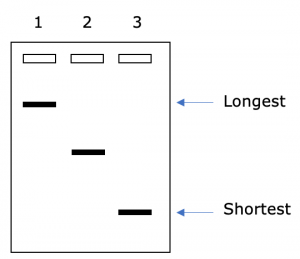
Ane private DNA molecule cannot be seen on a gel. Still, all of the DNA molecules that are the same size will motion the aforementioned distance through the gel. They will course a "ring" of DNA that tin be seen (Figure four). The intensity or darkness of a band is due to the number of molecules of Dna that are running at that position on the gel. More DNA will cause the ring to exist darker. Less DNA volition cause the band to be lighter.
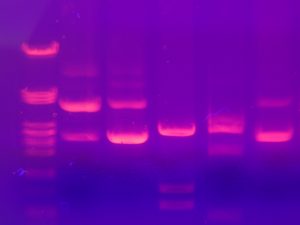
The size of DNA molecules is commonly measured in base pairs (bp). One base of operations pair consists of the nucleotides on the two strands of Dna that are hydrogen bonded together. For example, if in that location is an A on i strand of the DNA double helix, at that place would be a T on the second strand. The A and the T together are referred to every bit one base of operations pair. Larger lengths of Deoxyribonucleic acid can be measured in kb (kilo base of operations pairs; one thousand base of operations pairs).
Restriction Enzymes
A Deoxyribonucleic acid fingerprint is created by first digesting a Dna sample with a restriction enzyme. Restriction enzymes recognize very specific Dna sequences (such as v'-GAATTC-3'), which are unremarkably palindromes. Palindromic sequences allow the same sequence to be recognized on both strands of DNA (Figure 5, acme). The restriction enzyme will then cut the Dna at a specific bespeak. You tin think of restriction enzymes equally very specific molecular scissors. In the summit DNA sequence seen in Effigy 5, the brake enzyme EcoRI recognizes the sequence GAATTC and cuts between the One thousand and the A on both strands of DNA.
A indicate mutation (a change in one base in the Dna) can modify the site a brake enzyme recognizes and eliminate the restriction site (Figure five, bottom). The restriction enzyme will not cut the DNA since its recognition site is no longer present. Alternatively, the signal mutation could create a new restriction site where there was not one originally. If the brake site is present, 2 curt fragments volition be produced. In contrast, if the restriction site is absent-minded, one long fragment will remain intact. Other than identical twins, no two individuals volition accept the aforementioned Dna fingerprint. The genomes of any two not-identical individuals will comprise a large number of differences in the Deoxyribonucleic acid sequence that have the potential to change restriction sites.

DNA Fingerprinting
Subsequently the DNA has been digested with 1 or more restriction enzymes, it is separated past size using gel electrophoresis. A radioactive probe is and then used to identify certain fragments of DNA that may differ between individuals. Past comparing the size of DNA fragments produced by restriction digest, the "Dna fingerprint" of an private tin can be generated. A DNA fingerprint would look similar to the gel seen in Figure half-dozen.

Dna fingerprints can be used to place suspects when a crime has been committed. In this instance, the bands in the DNA fingerprint of the culprit would be an exact match to the bands in the DNA fingerprint made from Deoxyribonucleic acid that had been taken from the crime scene (Effigy 7).
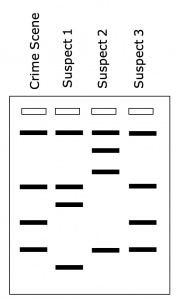
Deoxyribonucleic acid fingerprinting tin can also be used to decide paternity. In the case of paternity, the Dna of a child would exactly match the Deoxyribonucleic acid of either of the two parents. In fact, you would expect that simply well-nigh 50% of the bands in a child would match each parent (remember that meiosis generates haploid gametes that each incorporate ane copy of each chromosome). However, all the bands in the child must come from one of the 2 parents: the kid cannot take DNA that does not match with one parent or the other. Therefore, if any bands are not from the mother, they must exist from the child'southward begetter. Using this type of analysis, the paternity of an individual can be determined.
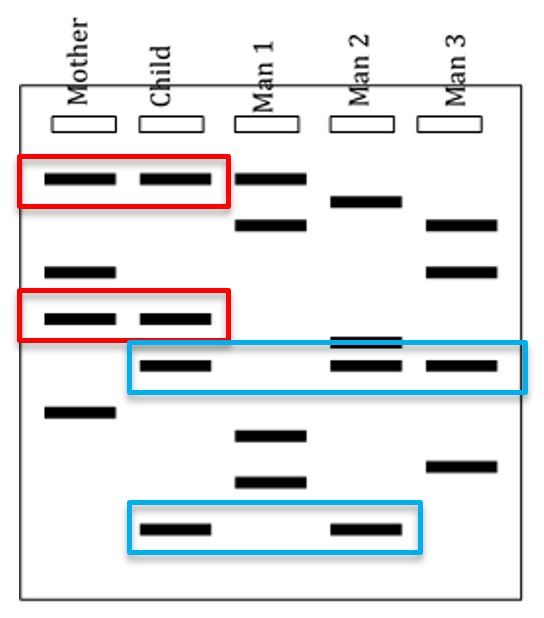
If you look at the DNA fingerprint in Effigy 8 above, you volition find that 2 of the bands match betwixt the mother and the kid (reddish boxes). The remaining two bands in the kid must therefore have come up from the father. Although Man 1 has 1 band that matches the child, that band can be accounted for from the mother. Neither of the two bands from the child that did non come up from the mother came from Man ane, so Homo 1 is eliminated every bit a potential male parent. Man ii and Man iii both have a ring that matches i of the kid's bands (top bluish box), but only Man 2 could accept given the child both the bands that information technology did not become from the mother. This ways that Human being 2 must be the father.
Additionally, DNA fingerprints can be used to make up one's mind evolutionary relationships between organisms. Organisms with more than like DNA fingerprints must be more than closely related than organisms with more dissimilar Dna fingerprints. This is because organisms with more like DNA fingerprints must have more like DNA.
Source: https://openoregon.pressbooks.pub/mhccbiology112/chapter/gel-electrophoresis-and-dna-fingerprinting/
0 Response to "How to Read a Electrophoresis Gel and See Who the Father Is"
Post a Comment